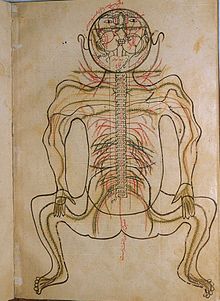Mansur ibn Ilyas
Manṣūr ibn Muḥammad ibn Aḥmad ibn Yūsuf Ibn Ilyās ( Arabic منصور ابن محمد ابن احمد ابن يوسف ابن الياس) was a Persian doctor from Shiraz who lived in the 14th and 15th centuries. Lived in the 16th century during the rule of the Timurids . He published an atlas of human anatomy, in Arabic تشريح بدن انسان, DMG Tashrīḥ-i badan-i insān 'The structure of the human body', also known as the "Anatomy of Mansur".
Life
Mansur ibn Ilyas was born in the middle of the 14th century in the Persian city of Shiraz, in the province of Fars, into a wealthy family. He probably received his first education in his family, whose members were also scholars, doctors and judges. It is known that he later traveled to several other cities, including several times to Tabriz , the capital of the Timurids , and a scientific and artistic center of his time.
Works
Mansur is the author of several medical manuscripts, including a general survey of medical knowledge, the Kifaya-yi Mansuri . His best-known work is the Tashrihi Mansuri , a systematic anatomical work with color illustrations of the various organ systems. His works are in the tradition of Hippocrates , Ibn Sina and Rhazes .
Tashrīḥ-i badan-i insān - the anatomy of Mansur
The "Anatomy of Mansur" ( Arabic تشريح بدن انسان, DMG Tashrīḥ-i badan-i insān 'The structure of the human body') was commissioned by Zayn al-Abidin, the last governor of the Muzaffarid dynasty. The manuscript consists of about 40 folio sheets and contains seven sections: Introduction, five chapters on the skeletal, nervous, muscular, venous and arterial systems, and an appendix on the development of the fetus and organs such as the heart and brain. He discusses the organs according to groups, which he arranges according to their importance for the life of the human body:
- Respiratory tract;
- Food system;
- Perception;
- Reproduction,
The anatomy of Mansur is one of the first color-illustrated anatomical works of Persian-Arabic-Islamic medicine
Doctors and philosophers of the time debated whether the heart or the brain would form first in the fetus. Mansur's anatomy also deals extensively with this discussion. He advocates that the heart should develop first, contradicting Hippocrates, who gave priority to the brain. Mansur's argument was that the seed consists of the element air and intense heat, which together form the pneuma , which needs a container in order not to dissolve again. The pneuma is contained in the heart, the natural source of heat in the body, and creates and nourishes the body from the heart. Next, the liver, the body's food source, is formed. Finally, the brain contains the senses, and these give life to the body. If, as Hippocrates claimed, the brain arose first, then it would have nothing to initiate the formation of other organs. The heart must form before the brain so that the brain can then transfer its forces to the rest of the body.
effect
The Anatomy of Mansur is not the first anatomical work, but it was the first color-illustrated anatomical atlas of Islamic medicine and had a great influence on the conception of human anatomy in this medical tradition. While his illustrations show the influence of earlier anatomical illustration traditions, especially the Greek and Roman anatomists of the Alexandria School, his portrayal of a pregnant woman is considered to be Mansur's own work.
Digitized work
- Individual pages from the "Anatomy of Mansur" (Historical Anatomy on the Web. US National Library of Medicine): Mansur ibn Ilyas: Tashrīḥ-i badan-i insānتشريح بدن انسانonline , accessed December 28, 2015.
literature
- Karl Sudhoff . A contribution to the history of anatomy in the Middle Ages, especially anatomical graphics based on manuscripts from the 9th to 15th centuries. In: Studies on the History of Medicine. Puschmann Foundation, No. 4, Leipzig 1908, pp. 52–73 Digitized version and panels X-XVIII (digitized version )
- Manfred Ullmann : Medicine in Islam. EJ Brill, Leiden 1970, p. 180.
- CA Storey: Persian Literature: A Bio-Bibliographical Survey. Volume II, Part 2: Medicine . Royal Asiatic Society, London 1971.
- Lutz Richter-Bernburg: Persian Medical Manuscripts at the University of California, Los Angeles: A Descriptive Catalog . In: Humana Civilitas . tape 4 . Udena Publications, Malibu 1978.
- Fateme Keshavarz: A Descriptive and Analytical Catalog of Persian Manuscripts in the Library of the Wellcome Institute for the History of Medicine . Wellcome Institute for the History of Medicine, London 1986, p. 123-129, 340-342 .
- Gul Russell: Ebn Elyas. In: Encyclopædia Iranica. Volume 8, pp. 16-20 (online) , accessed December 28, 2015
Web links
Individual evidence
- ^ Islamic Culture and the Medical Arts: Anatomy. US National Library of Medicine. US National Library of Medicine, Apr. 15, 1994. Web. 21 Apr 2015.
- ↑ a b M. Khalili et al. a .: Illustration of the heart and blood vessels in medieval times. In: Int. J. Cardiol. 2010, doi: 10.1016 / j.ijcard.2009.11.061
- ^ Andrew J. Newman: Tashrīḥ-i Manṣūr-i: Human Anatomy between the Galen and Prophetical Medical Traditions. In: La science dans le monde iranien à l'époque islamique . Institut Français de Recherche en Iran, Tehran 1998, p. 253-271 .
- ↑ Robert Herrlinger: History of the anatomical illustration . tape 1 : From antiquity to 1600 . Moss, 1967.
| personal data | |
|---|---|
| SURNAME | Ilyas, Mansur ibn |
| ALTERNATIVE NAMES | Ilyās, Manṣūr ibn Muḥammad ibn Aḥmad ibn Yūsuf Ibn |
| BRIEF DESCRIPTION | Persian physician and anatomist |
| DATE OF BIRTH | 13th Century |
| DATE OF DEATH | 14th Century |
